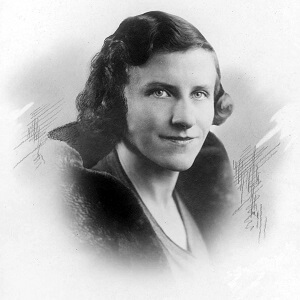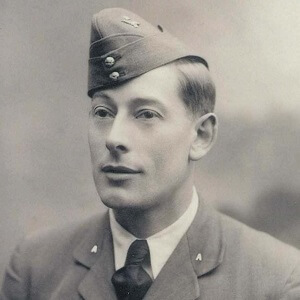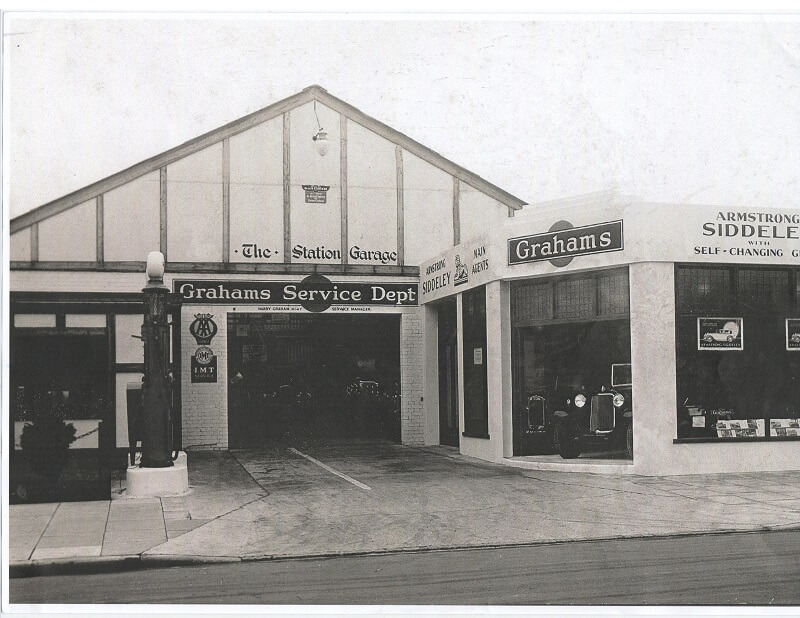Doreen Wright – pioneering sportswoman, founder of Amersham Swimming Club, and local councillor for 17 years
By Judy Thompson and Alison Bailey January 2023

Doreen Wright, who lived in Amersham for nearly 70 years, won a gold medal in the swimming relay at the 1930 inaugural British Empire Games. In 1933 she captained the England Women’s Ice Hockey Team against France and also designed their kit! In 1966, in a room above the Griffin Pub, Doreen led a team of swimmers to found Amersham Swimming Club, no mean feat in a town which still did not have a public pool! She had this covered though. As a formidable councillor on Amersham Rural District Council, she fought a long battle to have a swimming pool built and despite tremendous opposition this finally opened in 1967. In October 1997 Amersham Swimming Club celebrated its 30th Anniversary gala with Doreen, age 90 as guest of honour. Today the club has moved to the new Chilterns Lifestyle Centre, has around 300 members and is one of the most competitive in the region.
Widowed at 32, Doreen had to bring up her children alone whilst continuing to run her husband’s business, Station Garages Ltd. She still made time to pursue her interests in art, crafts, and textiles and was a founder member of the Lace Guild. She published a book on bobbin lace making, but perhaps should be best remembered for the poignant wartime diary she wrote as a series of letters to her beloved husband Gilbert, a pilot in the RAF, who was declared missing in action in 1940.
Early life
Mary Doreen Cooper was born in 1907, into a prosperous family in the British island colony of Ceylon (now Sri Lanka), where the family ran tea plantations. The eldest of four girls, she was sent ‘home’, age 11, for an English education at boarding schools in Sussex. Having decided that she would like to become a designer, she crammed to get a place at Cheltenham Ladies College so that she could get the entry qualifications for college. When she turned 18, her supportive father gave her the choice of ‘coming out’ as a debutante or having a car. She chose the car, and a course in design at the Royal College of Art!
Sports
Doreen played tennis, water polo and ice hockey at Cheltenham and continued to play competitive ice hockey in London at the Grosvenor House Hotel and Queens Club, becoming captain of the England Women’s Ice Hockey Team. Her sister Joyce was a swimming star, who held many swimming records and won bronze and silver medals in the 1928 Olympic Games in Amsterdam. Doreen’s own competitive swimming career began after she became fed up of making sure that Joyce kept to her training schedule and decided to join her in training for the 5-mile Ladies Long Distance Swimming Championship in the Thames. This is the same course as the Oxford v Cambridge Boat Race, but in reverse. Joyce won the race four years in succession.
Doreen became involved in the politics of swimming with the Amateur Swimming Association, encouraging it to found national swimming championships. When the Mermaid Swimming Club, the sisters’ training club in Swiss Cottage, proposed rejecting a membership request made by the daughter of a prominent Jewish family, both sisters declared that they would leave if the application was refused. The Cooper sisters were famous as their sporting successes were widely reported in the national press and the application was successful.
The British Empire Games

In the 1930 inaugural British Empire Games (later renamed The Commonwealth Games) in Hamilton, Canada, Doreen and Joyce were both selected to represent England in swimming. This was the only sport open to women competitors at the event, whilst men competed in athletics, boxing, lawn bowls, rowing, swimming, diving and wrestling. 17,000 people attended the opening ceremony on 16th August. England won 25 gold medals, topping the leader board, and Doreen won her gold in the 4 x 100-yard freestyle relay, with her sister Joyce, in 4:32.8 minutes. Sailing home on the Empress of France, the sisters returned as national heroes.
Joyce won four gold medals at the games and is one of Britain’s most successful swimmers. She finished her Olympic career at the 1932 games in Los Angeles with a bronze medal, whilst suffering from suspected appendicitis but did not retire from competitive swimming until after her marriage to the fellow Olympian, rower John “Felix” Badcock in 1934.

Gilbert Wright

Before Doreen left Canada, she managed to visit some tourist sights. At one of these, the Plains of Abraham in Quebec, she met her future husband, Gilbert Wright. Gilbert was the eldest son of a wealthy Midland ironwork manufacturer and had travelled to Canada to help his brother at the family’s fur farm. He met Doreen as he was returning home to Bromley in Kent where he worked in the motor trade, having bought into a garage there. After leaving Harrow School, Gilbert trained as an engineer and was passionate about cars, motorbikes and airplanes. He qualified as a pilot in 1931 and was accepted as a Pilot Officer with 605 Squadron of the Auxiliary Air Force. This was a reserve squadron, based in Castle Bromwich, made up of well-off young men like Gilbert for whom flying was a hobby.
Doreen and Gilbert became engaged three years after they had met and were married in Kingston Upon Thames, June 1934. Due to Doreen and Joyce’s fame (Joyce was her bridesmaid) the wedding was widely reported in the press. The newlyweds moved to Buckinghamshire, to a house that Gilbert had first spotted whilst taking aerial photos around the outskirts of London. Charlcote, Harewood Road, off Cokes Lane, Chalfont St Giles was to be Doreen’s home for the next 70 years.
Gilbert established a new business partnership with Don Stanton, purchasing Station Garages, a small chain of garages around Amersham from William Graham. The men and their wives were directors of the company, with Eddy Hearne as manager of the Amersham branch and Stan Yerby, as manager of Little Chalfont.
World War II
During the lead up to WWII, 605 Squadron was converted to a fighting squadron and Gilbert was called up in August 1939. Doreen and their three young children (Nick 4, and twins Bill and Mary 1) were invited by Gilbert’s parents to live with them at Wootton Court in Warwickshire. Charlecote was then let by Swannell & Sly for three years to accommodate the night staff of an evacuated children’s home. With a nanny to help with the children, Doreen was able to commit to war work with the Women’s Volunteering Services.
The 605 Squadron was trained to fly Hawker Hurricanes and moved to RAF Wick in Caithness. For a time, this was the busiest sector in Fighter Command due to Luftwaffe attacks on Scapa Flow. Doreen drove their Armstrong Siddeley, with carefully rationed petrol, from Warwick to Wick, in the far north of Scotland, to visit Gilbert early in May 1940. A few days later the Squadron was transferred to Kent to act as ‘Firemen’ across the channel in daylight hours to give cover to the British Expeditionary Force in France. Gilbert did not return from one of these missions on 22 May 1940. Doreen received a telegram 24 May advising her that her husband was reported missing, and this was followed by a letter from his commanding officer saying that it was believed that Gilbert’s plane had been shot down in enemy territory.
From 29 May 1940 Doreen started to keep a private diary of the daily life of her young family. This was intended to keep Gilbert ‘posted’ about everything he’d missed on his return, and enabled her to feel connected to him. As she wrote in July 1940, “I do so love to have just these few words with you each night. It doesn’t make you feel so lost and far away from me”. The diary provides a unique insight into how the war and Gilbert’s absence affected all aspects of the family’s life and the communities in Warwickshire and Amersham. The period covered includes the Battle of Britain, the bombing of Pearl Harbour and the blitzkrieg of nearby Coventry, when Doreen towed the WVS Canteen to provide emergency refreshments to the exhausted people of the city.
Doreen continued to write the diary until she received a letter from the Air Ministry dated 8 February 1943 which shattered her hopes that Gilbert would return. This confirmed that F/O Gilbert Wright had died 22 May 1940 and was buried in Berneville, Pas de Calais.
Thanks to Doreen, Gilbert Wright is commemorated on War Memorials at All Saint’s Church, Leek Wootton, St Michael’s Church, Chenies, St Giles Church, Chalfont St Giles, Harrow School and the Reading Room, Chalfont St Giles.
Amersham
With incredible courage and resilience, Doreen moved back to Chalfont St Giles, after receiving confirmation of Gilbert’s death, to start life again and to ensure the continuing success of the garage business.
More tragedy followed the next year when Doreen’s eldest son, Nick, age eight, died suddenly of tuberculosis following scarlet fever. Doreen was totally devastated at losing Nick. He was the only one of her children who could remember Gilbert, as the twins were only two when they last saw their father. Once again, she picked herself up and carried on, turning her attention to bringing up the twins as a single mother and ensuring that Charlecote was a loving home. Swimming remained a passion and there was an outdoor pool in the garden which she heated to over 28 degrees from April until November so that she could swim most days.

Station Garages, however, became her main focus to secure her children’s future. When Don Stanton returned from the army at the end of the war, she took her husband’s place in the partnership to expand the business. Together they developed garage sites on London Road, Amersham, Little Chalfont and High Wycombe and acquired new car dealership franchises for Triumph, Rover and Vauxhall. Like Don Stanton’s son, Bill joined the business after serving in the military. He became a director and with a loan from the bank the Wrights were able to buy out the Stantons. With Bill as Managing Director, Doreen retired in 1971 and the business was then sold in 1973.
Councillor
Doreen was first co-opted on to Chalfont St Giles Parish Council in 1947 before being elected as a Conservative councillor representing Chalfont St Giles and Jordans on the Amersham Rural District Council in 1950. She brought the same energy and tenacity to local politics as she did to everything else, serving on various committees and working groups. In addition to her battle over the Amersham swimming pool, she also fought for sheltered housing in Chalfont St Giles and much needed social housing in the form of high-density flats on White Lion Road, Amersham Common.
Crafts
Doreen was a member of the WI in Leek Wootton and joined the Chenies branch on her return to Bucks, later becoming president. A member of the Embroiderers’ Guild, she joined the Craft Committee of the Bucks County Federation and went on train in Shows and Programmes at Denman College, the WI’s centre of “Learning and Development”. She was a later president of the Federation. She lectured widely on “The Story of Lace” having learnt the craft whilst recovering from a kidney operation in 1947. Her research led her to publish her book Bobbin Lace Making, a comprehensive guide to the story of and art of lace in 1971. She held an exhibition on crafts at Foyles Gallery in 1973 and founded the Lace Guild in 1976. She was chairman and member no 00001 and was later invited to St Helena and South Africa to pass on her skills whilst in her 70s. Following her death, donations were given in memory of Doreen to the Lace Guild to establish a bursary for young lacemakers.
In addition to the bobbin lace, she continued with her textile design and painting, but also made lamp shades, baskets, sculptures, pottery, and bobbins amongst other things! She even took up glass engraving, inspired by the work of artist John Hutton at Coventry Cathedral. An example of her glass engraving can be seen at St George’s Church, Amersham Common where there are also hassocks (kneelers) designed or made by Doreen.
Doreen lived to the grand age of 95 years, passing away, as she wished, at Charlcote on 23rd August 2003. Her funeral was held at St Michael’s Church, Chenies with The Royal Airforce Hymn sung in memory of Gilbert. The diary was discovered in the attic at Charlecote by her children whilst they were clearing out the house before it was sold and later demolished for a larger house.
Thanks to the Heritage Lottery Fund, volunteers at the Leek Wootton History Group, and Doreen’s children, the diary was published in 2012 under the title Doreen’s Diary: She Could Not Have Loved More, The Wartime Diary of Doreen Wright.
In addition, the Leek Wootton History Group has archived, catalogued and digitised Doreen Wright’s papers at the Warwickshire County Record Office. It has also started an oral archive, developed learning packs for schools, and created two WWII walks. More information can be found here Doreen’s Diary – Leek Wootton & Guy’s Cliffe (leekwoottonandguyscliffe.org.uk)
Sources
Doreen’s Diary She Could Not Have Loved More, The Wartime Diary of Doreen Wright, published by the Leek Wootton History Group, 2012
Torontoist article, Jamie Bradburn July 21 2015. The British Empire Games of 1930 (torontoist.com)
Hamilton 1930 | Commonwealth Games Federation (thecgf.com))
Toronto Public Library
Burlington Historical Society
Carters.com
Doreen Cooper Biography | HowOld.co
Ancestry.co.uk
British Newspapers Archive

